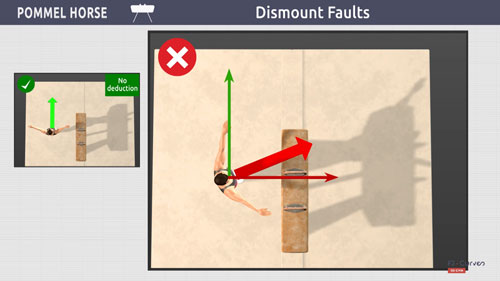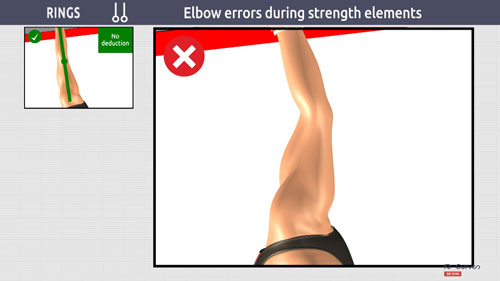Choose your apparatus
Landing
The différents deduction on landing.

Covered Chapters
- 1/Step and Hop
- 2/Falls
Lowering of chest on landings
Lowering of chest and extreme bending on on landings

Covered Chapters
- 1 - Lowering of chest
- 2 - Extreme bending
PB - Front uprise
Article 14.2.1.4
h) A front uprise should be performed with the back horizontal with the bars, an angle of up to 45º to horizontal will have a small deduction and below 45º a medium deduction.
i) A front uprise to L sit can be deducted for lack of amplitude in the uprise, 0.1 or 0.3.
h) A front uprise should be performed with the back horizontal with the bars, an angle of up to 45º to horizontal will have a small deduction and below 45º a medium deduction.
i) A front uprise to L sit can be deducted for lack of amplitude in the uprise, 0.1 or 0.3.

Covered Chapters
- 1/ Front Uprise
- 2/ Front uprise to L sit
Legs faults
Deduction when gymnast do legs faults

Covered Chapters
- 1- Apart
- 2- Bent
- 3- Combined: Bent/Apart
POMMEL HORSE - Lack of amplitude in scissors and single leg swings
Here the differents deductions for lack of amplitude in scissors and single leg swings

Covered Chapters
- 1/ Scissors and swing
Floor - Open Legs during Flight elements (twists and saltos)
We must pay attention on leg crossed during flight phase in saltos with twist.
The shoulder during saltos and/or on landing is decisive
The shoulder during saltos and/or on landing is decisive

Covered Chapters
- 1/Tuck
- 2/Pike
- 3/Saltos with twist
VAULT - The splitting of legs in the Tsukahara and Kasamatsu
illustration of a common fault on Vault during the first flight of Tsukahara and Kasamatsu

Covered Chapters
- 1/ Apart
POMMEL HORSE - Angular deviations in cross support circles and travels
0°-15° = 0 ded
16º- 30º = 0.1
31º- 45º = 0.3
>45º = 0.5 +NR
16º- 30º = 0.1
31º- 45º = 0.3
>45º = 0.5 +NR

Covered Chapters
- 1/Angular deviation in cross
- 2/ Cumulative deduction
Incomplete twists
Technical deductions for angular deviation from the perfect end position

Covered Chapters
- 1/Deduction on twists
Bent arms
Differents deductions about Bent arms

Covered Chapters
- 1/ Differents bent arms
- 2/ Exemple on 6 apparatus
Hips breaks with circles
Article 11.2.1 section c:
"Ideally circles and flairs must be performed with complete extension. Lack of amplitude in body position is deducted as an individual deduction on for each element"
"Ideally circles and flairs must be performed with complete extension. Lack of amplitude in body position is deducted as an individual deduction on for each element"

Covered Chapters
- 1/Circle
- 2/Flair
Expectations for scissor to handstand elements
5 chapiters for explain all deductions on scissor to handstand element ( Article 11.2.1.3 (j) , (k ) of COP)

Covered Chapters
- 1/ Visible strength
- 2/ Hip bend
- 3/ Hand(s) stepping
- 4/ Close the legs
- 5/ Non recognition
POMMEL HORSE - Touching or hitting apparatus with legs or feet.
Touch = 0.1
Hit = 0.5
Fall = 1
Hit = 0.5
Fall = 1

Covered Chapters
- 1/Contact-Heavy contact
- 2/Falls
POMMEL HORSE - Landing oblique or not facing out from the long axis of horse.
deviation >45º = 0.1
deviation >90º = 0.3
deviation >90º = 0.3

Covered Chapters
- 1/Deviation
RINGS - Excessive swing of cables.
Little swing = no ded
Excessive swing = 0.1/element
Excessive swing = 0.1/element

Covered Chapters
- 1/Swinging in the elements
PB - During swing element which pass through or end in handstand
During swing elements which pass through or end in handstand (see additional rule Art. 15.2 for Horizontal Bar), deviations from the correct position will be penalized as follows:
up to 15º No deduction.
>15° to 30º Small error.
>30° to 45º Medium error.
> 45º Large error and non-recognition (D jury).
up to 15º No deduction.
>15° to 30º Small error.
>30° to 45º Medium error.
> 45º Large error and non-recognition (D jury).

Covered Chapters
- 1/ Differents deviations
- 2/ Examples
RINGS - Elbow errors during strength elements
Small = 0.1
Medium = 0.3
Large = 0.5
Medium = 0.3
Large = 0.5

Covered Chapters
- 1/Bending
- 2/Strengh examples
RINGS - False grip (over grip) during strength holds (each time).
False grip = 0.1

Covered Chapters
- 1/Bending
- 2/Strength examples
RINGS - Holding Strength elements
2 s = no ded
approx 1 s = 0.3 ded
0 s = 0.5 + NR
approx 1 s = 0.3 ded
0 s = 0.5 + NR

Covered Chapters
- 1/Time
- 2/Strength examples
High Bar - Bent knees during swing actions
Article 15.3 Specific Deductions for Horizontal Bar - E Jury
To 60° = 0.1
Over 60° = 0.3
To 60° = 0.1
Over 60° = 0.3

Covered Chapters
- 1/ Differentes deductions
- 2/ Examples
Do you want to know more?
* Prices in Euro and Dollar may change slightly due to daily exchange rate
License
simple (WAG +MAG)
150 videos
100 £/year
120 €/year
$125/year
for 1 year
(The subscription is not automatically renewed)